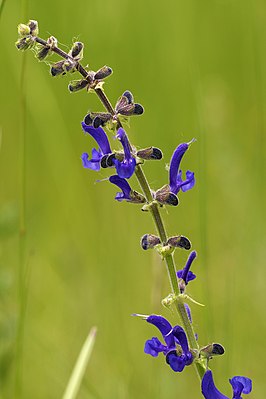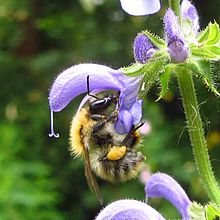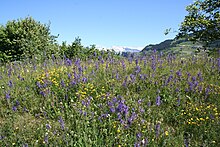Meadow sage
| Meadow sage | ||||||||||||
|---|---|---|---|---|---|---|---|---|---|---|---|---|

Meadow sage ( Salvia pratensis ) |
||||||||||||
| Systematics | ||||||||||||
|
||||||||||||
| Scientific name | ||||||||||||
| Salvia pratensis | ||||||||||||
| L. |
The meadow sage ( Salvia pratensis ) is a type of sage and belongs to the family of mint .
features
The plant grows up to 60 cm and has light to medium blue flowers. The upright stems are square and have basal leaves. The flowering period extends from late May to August. A sage plant can live for several years.
Pollination is mainly carried out by bumblebees using the typical sage mechanism: The bumblebee sticks its trunk into the flower and through an eyelet on the lower lever arm to collect nectar, thereby triggering the lever mechanism (also known as the turnpike mechanism) that pulls the pollen on hairy body of bumblebee strips off. The pollen is then carried on from the bumblebee to other flowers.
The species has the number of chromosomes 2n = 18.
ecology
The meadow sage is a perennial half-rosette plant and a light plant that remains sterile with less than 20% of normal light enjoyment. Wrinkled leaves and essential oils have an antiperspirant effect. The taproot extends over 1 m deep.
The flowers are pre-male "actual lip flowers". The lower lip serves as a seat for the pollinators, the helmet-shaped upper lip hides the two stamens and style . Due to the strong growth of the connective, i.e. the dust bag intermediate piece, the dust bag halves have moved far apart. One of the two connections has been converted into a “plate” and acts as a lever. When insects press the plate blocking the throat, the lever mechanism is released and the extended anthers arm strikes the insect's back, thereby transferring the pollen . In addition to the hermaphrodite, there are also smaller female flowers. The nectar is only accessible to long-nosed insects; the lever mechanism can only be operated by bumblebees , more rarely by other bees . The lever mechanism can also be triggered repeatedly by the pollinators . However, only a subset of the pollen is released; A portioning of approx. 12 pollen portions is possible. In addition to pollination by insects, self- pollination is also important. The flowering period extends from late May to August.
The fruits are split fruits that disintegrate into 4 chubs. They act as animal and wind spreaders, as well as sticky and rain ballists because of the horizontally protruding cups. Fruit ripening is from July to August.
Location
The meadow sage loves calcareous, nutrient-rich soils in dry, sunny locations and is common in large parts of Europe, mostly up to an altitude of 1,600 m. In the Allgäu Alps in Bavaria, it rises between Schlappoltsee and Schlappoltalpe up to 1710 m above sea level. He is naturalized in the northeastern United States.
General distribution
The meadow sage occurs in Europe, in Asia Minor (rarely), in the Caucasus and introduced in North America. It is a Festuco Brometea class character in Central Europe.
Its original home in Europe is the Mediterranean area, meanwhile the closed distribution area in Europe extends to approx. 50 ° north latitude, further north there are mostly only isolated and inconsistent occurrences up to central Sweden.
Systematics
One can distinguish the following subspecies:
- Salvia pratensis subsp. bertolonii (Vis.) Soó : It occurs from Italy to the northwestern Balkan Peninsula.
- Salvia pratensis subsp. haematodes (L.) Arcang. : It occurs in Italy and Crete.
- Salvia pratensis subsp. laciniosa (Jord.) Briq. : It occurs in France.
- Salvia pratensis subsp. pozegensis (Watzl) Diklic : It occurs on the northwestern Balkan peninsula.
- Salvia pratensis subsp. pratensis : It occurs in Europe.
The hybrid with the grove sage ( Salvia nemorosa L. ) is Salvia × sylvestris L. = Salvia nemorosa × Salvia pratensis . Its distribution area is Europe.
use
You can use young meadow sage leaves, similar to those of kitchen sage , as a spice, for example for fish dishes. However, the effect is far less intense than that of kitchen sage.
Sources and Notes
- ↑ M. Reith, G. Baumann, R. Claßen-Bockhoff, T. Speck: New insights into the functional morphology of the lever mechanism of Salvia pratensis (Lamiaceae) Annals of Botany 2007 100 (2): 393-400
- ↑ a b c Erich Oberdorfer : Plant-sociological excursion flora for Germany and neighboring areas . 8th edition. Stuttgart, Verlag Eugen Ulmer, 2001. Page 809. ISBN 3-8001-3131-5
- ↑ Erhard Dörr, Wolfgang Lippert : Flora of the Allgäu and its surroundings. Volume 2, IHW, Eching 2004, ISBN 3-930167-61-1 , p. 418.
- ↑ a b c d e f Rafaël Govaerts (Ed.): Salvia pratensis. In: World Checklist of Selected Plant Families (WCSP) - The Board of Trustees of the Royal Botanic Gardens, Kew . Retrieved February 21, 2016.
- ↑ Rafaël Govaerts (Ed.): Salvia pratensis. In: World Checklist of Selected Plant Families (WCSP) - The Board of Trustees of the Royal Botanic Gardens, Kew . Retrieved April 24, 2020.
literature
- Aichele, D. / Golte-Bechtle, M .: What is blooming there? , 54th edition 1991 Kosmos Verlag
- Robert Zander : Zander concise dictionary of plant names. Edited by Fritz Encke , Günther Buchheim, Siegmund Seybold . 15th edition, corrected reprint of the 14th edition. Eugen Ulmer, Stuttgart 1994, ISBN 3-8001-5072-7 .
- Ruprecht Düll , Herfried Kutzelnigg : Pocket dictionary of plants in Germany and neighboring countries. The most common Central European species in portrait. 7th, corrected and enlarged edition. Quelle & Meyer, Wiebelsheim 2011, ISBN 978-3-494-01424-1 .
- Oskar Sebald, Siegmund Seybold, Georg Philippi, Arno Wörz (eds.): The fern and flowering plants of Baden-Württemberg . Volume 5: Special part (Spermatophyta, subclass Asteridae): Buddlejaceae to Caprifoliaceae. Eugen Ulmer, Stuttgart 1996, ISBN 3-8001-3342-3
Web links
- Meadow sage. In: FloraWeb.de.
- Meadow sage . In: BiolFlor, the database of biological-ecological characteristics of the flora of Germany.
- Salvia pratensis L. In: Info Flora , the national data and information center for Swiss flora . Retrieved February 21, 2016.
- Distribution in the northern hemisphere
- Thomas Meyer: Sage data sheet with identification key and photos at Flora-de: Flora von Deutschland (old name of the website: Flowers in Swabia )


